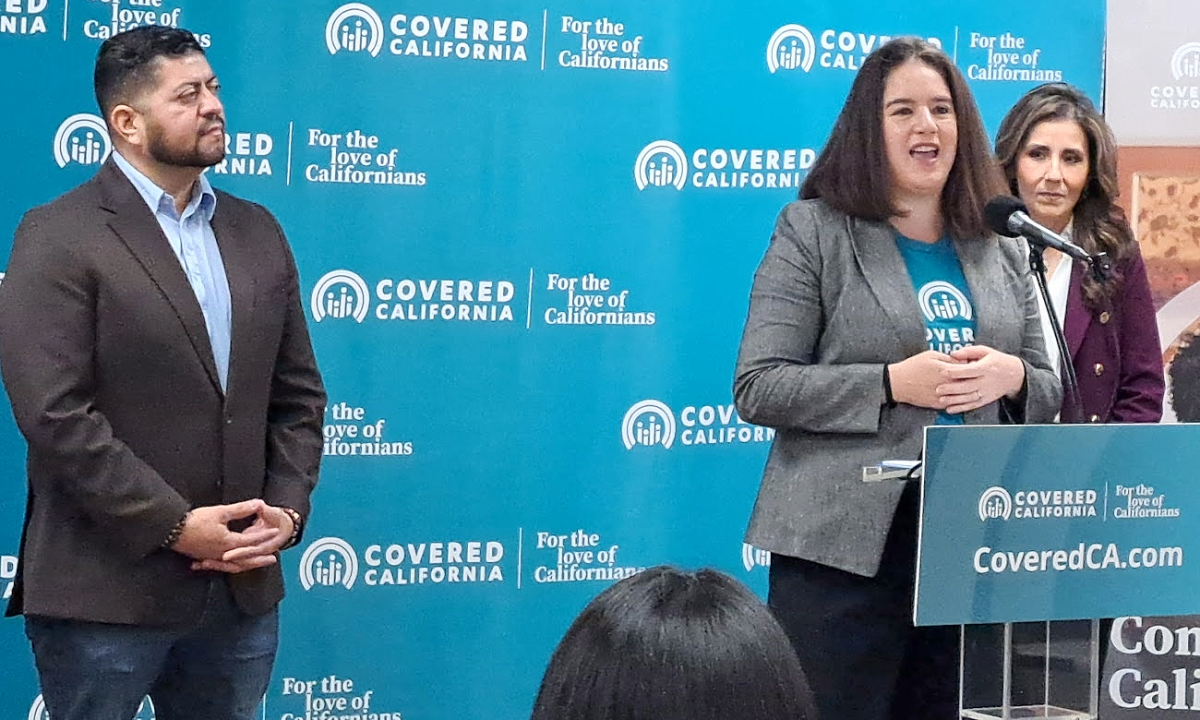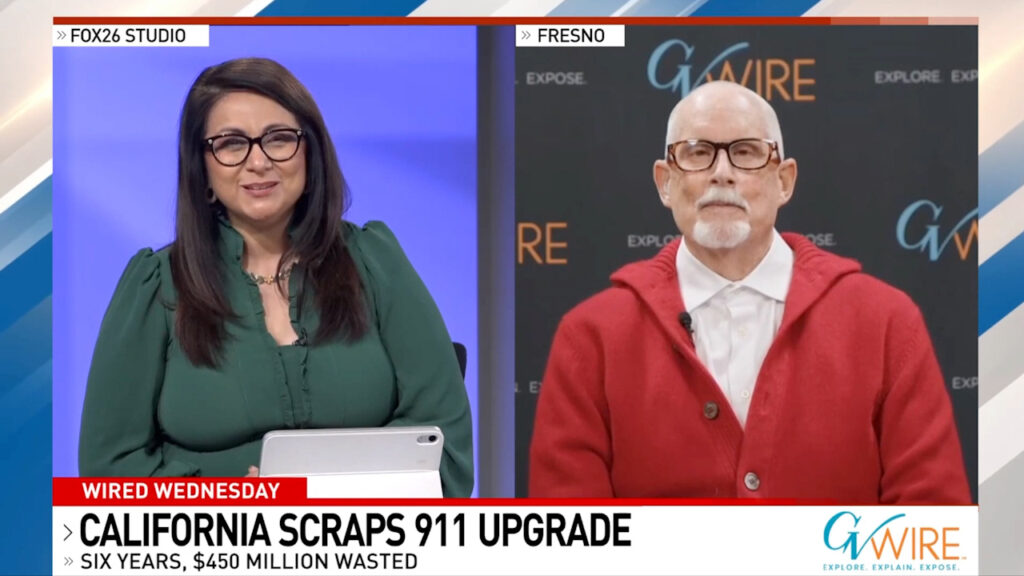Covered California Executive Director Jessica Altman addresses reporters at an event in Fresno to promote open enrollment in the state-backed Affordable Care Act marketplace, Thursday, Nov. 13, 2025. Joining her are Fresno County District 3 Supervisor Luis Chavez, left, and Dr. Olga Meave, CEO of Clinica Sierra Vista health clinics in Fresno and Kern counties. (Central Valley Journalism Collaborative/Tim Sheehan)

- Tens of thousands of San Joaquin Valley residents could lose their subsidized Covered California health insurance if federal credits expire.
- Thousands more will be forced to pay much higher premiums to retain Covered California health care.
- Democrats in Congress are pushing for the credits to be extended, but President Donald Trump and other Republicans have resisted.
Share
|
Getting your Trinity Audio player ready...
|
Fresno barber Juan Gonzalez expects to pay more than three times more for health insurance coverage through Covered California than he did in 2025 because federal tax credits that help subsidize the cost of his monthly premiums are set to expire at the end of December.

Tim Sheehan
The Intersection
“It was $44 per month before, and now I’m going to pay $140,” Gonzalez told CVJC through a Spanish-language interpreter in an interview Thursday, Nov. 13, at a Clinica Sierra Vista health clinic in south Fresno.
And while he’s optimistic about his ability to afford the higher premium, “it will depend on the income I earn every month,” he added. “If there’s money, I can pay easily, otherwise it will be tight.”
Gonzalez is among about almost 185,000 lower-income San Joaquin Valley residents – and nearly 2 million statewide – who, with the aid of the tax credits, purchase health insurance through Covered California, the state’s insurance marketplace under the federal Affordable Care Act (also known as Obamacare).
Despite the prospect of higher out-of-pocket costs for enrollees, state officials are urging eligible residents to sign up for health insurance through the program rather than risk going without coverage.
Enrollment Period Ends Jan. 31
Jessica Altman, executive director of Covered California, visited Clinica Sierra Vista’s Elm Dental Center in south Fresno that same day to promote the agency’s ongoing open-enrollment period which began Nov. 1 and continues through Jan. 31.
“Since 2021 the federal government has helped make monthly premiums cheaper for millions of Americans through what we call enhanced premium tax credits,” Altman said. “Those enhancements are set to expire at the end of the year and without congressional action, they will expire and people will face higher costs.”
“I have already heard from retirees facing the highest premium increases in the state, from parents who are juggling medical bills and other bills in their life, from young adults considering going without insurance, and small business owners uncertain if they can continue to make it on their own with the higher cost of coverage” Altman said.
The Affordable Care Act, or Obamacare, originally included tax credits to subsidize premiums for households earning up to 400% of the federal poverty level. The tax credits were expanded in 2021 as part of COVID-19 relief legislation for people or families with incomes above that level, and capping the out-of-pocket cost of premiums at 8.5% of income. But that expanded subsidy program came with a Dec. 31, 2025 expiration date.
Will Congress Renew Health Care Credits?
Democrats in Congress have been pushing throughout 2025 for the credits to be extended, but President Donald Trump and Republicans in the Senate and House of Representatives have resisted those efforts. The struggle over the credits was one of the key points of contention in a shutdown of the federal government that lasted for more than 40 days.
Several Democrats in the U.S. Senate voted Nov. 10 to join Republicans in passing a spending bill to reopen the government. They did not secure an extension of the tax credits, but won a promise from the Republican majority that the credits would be brought up for a vote in December. In the House of Representatives, enough Democrats voted with Republicans on Nov. 12 to end the shutdown, but without any such promise from Speaker Mike Johnson, R-Louisiana, for a vote on the credits.
People who enroll in Covered California to buy insurance through the marketplace are those who don’t have employment where they are offered affordable health benefits. That includes small business owners and their employees, people who are self-employed or “gig-economy” workers, and other types of workers. They make too much money to qualify for Medi-Cal, the state’s incarnation of the federal Medicaid program for low-income residents.
Covered California Enrollment in the Valley
In San Joaquin Valley counties, from Stockton in the north to Bakersfield in the south, about 202,000 people were enrolled as members of Covered California as of July. Of those, about 91% have their costs at least partially subsidized by tax credits:
- Fresno County: 48,340 members; 43,590 are subsidized, and their average net monthly premium is $80 per member. There are 4,760 members without subsidies, with an average monthly premium of $540 per member.
- Kern County: 34,730 members; 31,390 are subsidized, with an average net monthly premium of $86 per member. There are 3,350 unsubsidized members, with an average monthly premium of $558 per member.
- Kings County: 4,000 members; 3,580 are subsidized with an average net monthly premium of $86 per member. There are 420 unsubsidized members with an average monthly premium of $523 per member.
- Madera County: 6,960 members; 6,320 are subsidized with an average monthly net premium of $97 per member. There are 660 unsubsidized members with an average monthly premium of $549 per member.
- Merced County: 18,160 members; 17,050 are subsidized with an average monthly net premium of $24 per member. There are 1,100 unsubsidized members with an average monthly premium of $769 per member.
- San Joaquin County: 48,320 members; 44,560 are subsidized with an average monthly net premium of $101 per member. There are 3,760 unsubsidized members with an average monthly premium of $608 per member.
- Stanislaus County: 28,460 members; 26,090 are subsidized with an average monthly net premium of $113 per member. There are 2,370 unsubsidized members with an average monthly premium of $605 per member.
-
- Tulare County: 13,170 members; 12,020 are subsidized with an average net monthly premium of $107 per member. There are 1,150 unsubsidized members with an average monthly premium of $695 per member.
Because Congress did not vote to extend the subsidies before the federal fiscal year ended on Sept. 30, Covered California sent out renewal notices to its enrollees in mid-October reflecting the higher premiums that members would face for the various coverage options that are available. Altman had previously told CVJC that she expected “sticker shock” to cause some families to choose to go without coverage because they cannot afford the higher premiums.
In Fresno, Altman told CVJC that it’s too soon to determine if there has been an exodus of members.
“There are people who are kind of waiting and watching and seeing,” Altman said. “I expect our enrollment pattern to look different than it does in a normal year. …It may be, if it looks low, that people are waiting or disenrolling, but it’s really just too early.”
Some Enrollees Will Remain Eligible, but for Smaller Tax Credits
Some enrollees with incomes under the 400% poverty threshold will remain eligible for tax credits. “You have some people, if these expire, who will still get tax credits, but significantly less. And you have some people who will no longer get tax credits.”
Altman said Covered California’s statewide enrollment includes about 160,000 people above the 400% income level who are set to lose their tax credits entirely, in addition to about 250,000 to 300,000 people who currently don’t receive tax credits because of their income level.
The prospect of people opting to go without health insurance rather than pay higher insurance premiums is a worry for Dr. Olga Meave, CEO of Clinica Sierra Vista, a federally qualified health center nonprofit that operates clinics in Fresno and Kern counties that serves about 160,000 patients.
“My biggest concern is that patients are not going to be able to afford Covered California,” Meave told CVJC. “They’re not going to be able to qualify for Medi-Cal, so they’re going to be in limbo in between those options. They’re not going to get the coverage that they need, and they’re going to delay their care.”
Delaying routine health care for ailments opens the door for complications that can increase in severity – and increase the cost of care. “So by the time they end up at the hospital, or they do come here to us, it’s going to be a different scenario,” Meave said.
“It makes no sense to increase the cost of access to care, because we – I mean taxpayers – are going to pay a lot more,” she added. “Because what could have cost $100 is going to cost thousands of dollars, or even hundreds of thousands of dollars. One night in the hospital is probably more than the whole premium for a year.”
Valley Residents Without Health Insurance
Data released in September 2025 by the U.S. Census Bureau estimates that more than 291,000 residents in the San Joaquin Valley have no form of health insurance at all, whether Medi-Cal, Medicare, Veterans Administration, coverage through an employer or through the Covered California marketplace:
- Fresno County: 60,517 uninsured, 6% of the county’s population.
- Kern County: 69,622 uninsured, 7.7% of the population.
- Kings County: 8,825 uninsured, 6.4% of the population.
- Madera County: 13,001 uninsured, 8.2% of the population.
- Merced County: 21,340 uninsured, 7.2% of the population.
- San Joaquin County: 55,410 uninsured, 6.9% of the population.
- Stanislaus County: 27,431 uninsured, 5% of the population.
- Tulare County: 34,996 uninsured, 7.3% of the population.
Of the uninsured in the Valley, almost 102,000 were working in full-time, year-round jobs, while fewer than 61,000 did not work at all.
Statewide, the Census estimates indicate that there are more than 2.3 million uninsured, accounting for 5.9% of California’s population.
Altman said that even though enrollees are seeing higher premiums in their renewal notices, Covered California can still revise its cost structure if Congress does eventually extend the enhanced tax credit, starting with the promised December vote in the U.S. Senate.
“At this point, it’s always been uncertain whether anything would happen from Congress,” Altman said. “I think it’s more uncertain than ever with the news of the last few days.
Depending on if, when or how Congress acts, “we can reopen enrollment” for coverage reflecting the extension of the tax credits in hopes of gaining back those who may walk away because of the higher cost,” Aldman said.
“My message to consumers is, see what’s here now, make the decision that’s best and right for your family. We’re here to help,” she added. “And then if something does change, we will give you time, time to enroll, time to change your plan, so you will have that opportunity.”
Earlier in the week, however, two California State Assembly members, Fresno Democrat Esmeralda Soria and Mia Bonta, a Democrat from Oakland who leads the Assembly Health Committee, expressed skepticism that Republicans in Congress would reverse their opposition to extending the tax credit.
“We ended up having the Senate vote on passage of the budget with this supposed promise that there would be some agreement in December that would address these healthcare subsidies,” Bonta said.
Soria discounted the promise of the Senate GOP majority for a December vote. “We need things in writing, because I’ve heard about promises before, and we’ve had a lot of failed promises,” she said. “In our Valley, we can’t operate on promises. We’re already starting at a deficit, and so promises do us no good.”
About the Reporter
Tim Sheehan is the Health Care Reporting Fellow at the nonprofit Central Valley Journalism Collaborative. The fellowship is supported by a grant from the Fresno State Institute for Media and Public Trust. Contact Sheehan at tim@cvlocaljournalism.org.



















